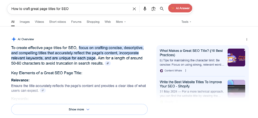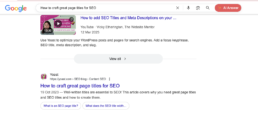Written by FiveStones – a certified Google Marketing Platform partner helping global brands grow through digital strategy and ad tech.
If your site metrics have been behaving oddly lately—steady or rising impressions but falling clicks—you’re likely experiencing the effects of Google’s evolving search experience. Since the public release of AI Overviews (AIOs) in May 2025, many marketers are seeing this exact pattern unfold.
And it’s not by accident. This is the new shape of search.
What are AI Overviews?
Google’s AI Overviews summarize answers to user queries at the top of the results page—pulling information from various sites and presenting it directly, powered by large language models (LLMs). This means that:
– Your brand may still be cited in the AI summary,
– But users might not need to visit your site anymore.
We’ve seen cases where impressions remained stable—or even grew—but click-through rates dropped significantly across both brand and non-brand queries. In some instances, this included sharp declines in blog and homepage traffic, even for evergreen topics. This signals a shift not in interest, but in user behavior.
What does this mean for marketers?
The traditional SEO logic—optimize, rank, get the click, convert—is now incomplete. AI Overviews have added a new step: satisfy the user’s need before the click ever happens.
And if their need isn’t answered, they don’t click.
While frustrating, this doesn’t mean your content failed. In fact, it may mean it’s doing exactly what it was trained to do: inform.
What should be the marketing funnel in an AI-led world?
Here are three mindset shifts marketers should adopt:
1. From Clicks to Credibility
Appearing in AI Overviews means your content is deemed useful and trustworthy by Google’s AI models. That’s a powerful brand signal—even if the user never lands on your site.
Measure brand presence within AI summaries, not just SERP position.
2. From Reach to Relevance
AIOs may reduce traffic volume—but they also filter for intent. Users who still click through are more motivated. These are the audiences worth focusing on.
Tailor your funnel toward lower-funnel conversion points, not just upper-funnel reach.
3. From Quantity to Quality (of Content)
To earn a spot in AI Overviews, your content needs to be clear, structured, and contextually rich. Vague blog posts won’t make the cut.
Answer questions well. Structure content with utility in mind.
What can marketers do next in light of AI Overviews?
How to Diagnose AIO Impact in Google Search Console(GSC)?
The core principle is this: AIO impact is not a ranking (Position) drop. It is a CTR collapse on pages that continue to rank highly.
Use this 3-step process in GSC to confirm the impact:
| Steps | Key Signal of AIO Impact |
|---|---|
|
1. Find the Initial Signal In the Performance report, compare YoY to find a significant CTR drop with stable Impressions. |
The first signal of AIO impact is a significant site-wide CTR drop while Impressions have remained stable or increased. This shows that user behavior on the SERP has changed, not your overall visibility. |
|
2. Isolate Affected Pages Go to the Pages tab. Filter your performance data by Pages and focus on your informational content (blog posts, guides, FAQs). Why? AI Overviews are designed to directly answer informational queries ("what is," "how to"). Users with this intent are the most likely to be satisfied by the AIO summary without clicking. |
A much steeper CTR drop on these specific pages compared to your commercial pages proves the issue is targeted, not a general site problem. |
|
3. Rule Out Ranking Issues Click into an impacted informational page. Go to the Queries tab. Filter Position < 4. |
If you see a severe CTR drop on these top-ranking queries, it's a sign that AIO is giving people what they need, so they don't have to click on your page. |
1. Monitor Shifts in CTRs and Impressions
Watch for post-May 2025 declines in CTRs despite stable impressions. This pattern suggests AIO exposure without clicks.
2. Search Your Key Queries
Manually search your most important terms. Are you showing up in the AI summary? Who is?
3. Structure Content for AI
Use clear headers, concise answers, and well-sourced claims. AIOs prefer digestible, expert-like formatting.
Structuring your content with clear headers and concise answers is now the price of entry to be cited by AIOs. Once you’re in the game, your 60-character meta title becomes your final pitch—a billboard on the SERP designed to advertise your unique value and win the actual click.


4. Track More Than Just Clicks
Consider adding metrics like:
- Appearances in AIOs (through manual audits or tools)
- Branded query growth
- Screenshot tracking of AI search results
5. Use AI to Analyze the Shift
Tools like Gemini or ChatGPT can help you detect performance anomalies, summarize shifts, and compare visibility across months.
Conclusion
The websites that win in this new era are those that aim for trust, not traffic. Visibility in AI Overviews might not always translate to a session. But it does shape brand perception. And when users are really ready, they’ll remember the name they saw first.
Frequently Asked Questions
Q1: What are AI Overviews and why are they affecting my website traffic?
AI Overviews are summaries powered by Google’s large language models, shown at the top of search results. They provide direct answers to user queries—often reducing the need to click through to websites, which can lead to lower traffic despite strong rankings.
Q2: If users aren’t clicking, does my content still matter?
Yes. Being featured in AI Overviews signals that your content is trustworthy and relevant. Even without a click, it helps build brand awareness and authority—crucial for long-term conversion and recognition.
Q3: How can I increase my chances of appearing in AI Overviews?
Structure your content clearly, answer questions directly within the first 40–50 words, and use headers and tables where appropriate. Adding FAQ schema also helps surface your content in “People Also Ask” boxes.
Q4: Should I still track clicks as my main performance metric?
Not on its own. Supplement click data with branded search volume, direct traffic, and engagement metrics like newsletter sign-ups. These reflect growing trust and awareness—even when users don’t immediately visit your site.
Q5: What’s the most important takeaway for marketers right now?
Treat every SERP as a brand impression opportunity, not just a traffic source. Your goal isn’t just to be clicked—it’s to earn trust and be remembered.
